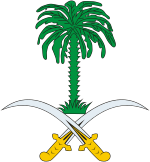Abu Omar
| The Emirate of Abu Omar | |
 |
|
| National flag | Coat of Arms |

| |
| Motto | Dominus illuminatio mea. |
| Capital | Ajaman |
| Languages - Official - Unofficial |
Arabic, English |
| Government Sultan - |
Mohammed ibn Al-Quuadi |
| Area |
183,885 km² 71,479 sq mi |
| Region | Union of Saint Holden |
| Accession to Union of St Holden | 1934 |
| Population - Total (2007) |
19,000,000 |
| National animal |
Tiger |
| Currency | Rudolph |
| International abbreviation | ABO |
| Internet TLD | .aabo |
| Calling Code | +212 |
Abu Omar (Arabic: أبو عمر , translated as 'Father of Omar.'), officially the Emirate of Abu Omar, is an emirate occupying a small section of the south coast on the Pellina island. It is bordered by Abu Hana to the east, Muhtaseb to the north and Haythamia to the north-west. The capital city is Ajaman (pronounced Arr-sha-maan).
Contents
History
Administrative divisions
Economy
Before the discovery of oil the economy of the Abu Omari region focused on fishing and pearling. The discovery of oil reserves, beginning in the 1940s, completely transformed the nation's economy. Now the country has a high standard of living, with many social services offered to its citizens and all the amenities of any modern nation.
Abu Omar's national income primarily derives from oil and natural gas exports. The country has oil estimated at 55 billion barrels, while gas reserves in the giant north field which straddles the border with Abu Hana and are almost as large as the peninsula itself are estimated to be between 800-900tcf (Trillion Cubic Feet - 1tcf is equal to around 80 million barrels of oil equivalent).
Omaris' wealth and standard of living compare well with those of other nations; While oil and gas will probably remain the backbone of Abu Omar's economy for some time to come, the country seeks to stimulate the private sector and develop a "knowledge economy". Since the finding of oil the government has began various projects with the aim of attracting tourism and business.
Geography
The Emirate of Abu Omar consists of 14 'Districts.' These are:
- Ajaman District
- Merdif District
- Al Satwa District
- Omar Pines District
- Emirate Hills District
- Khordassa District
- Al Muhammed District
- Al Ali District
- Al Quassa District
- Sheikh Faisal District
- Sheikh Ibrahim District
- Old Omari District
- Jasmina District
- Al Drya District
Population
Culture
Abu Omar explicitly uses Wahhabi law as the basis of its government, and the vast majority of its citizens follow this specific Islamic doctrine. Wahhabism is a puritanical version of Islam which takes a literal interpretation of the Qur'an and the Sunnah. Wahhabism takes a more tolerant form in Abu Omar than in other puritanical Muslim nations.
Almost all Omarian women wear the black abaya; the government, however, does not impose the style universally. The abaya is mainly passed down from generation to generation and is still present because of the traditional values of the country.
Education
Abu Omar is home to several International and local private schools and universities.
Primary and secondary schools
- Abu Omar Grammar School
- Abu Omar Indian School
- Abu Omar International School
- Al Galawa School
- Al Noodha National Schools
- Al Makawi School
- The St Samuel Community School of Abu Omar
- The St Samuel International School in Abu Omar
- The Allanean School
- International Community School
- Islamic School of Abu Omar
Colleges and universities
Communications
Sport
The most sport in Abu Omar is motor racing and horse racing, but in recent years, soccer has become huge. The domestic soccer league in Abu Omar has not yet attained the same level as those elsewhere in the region, but the international team has certainly lifted the popularity of soccer in the country. Most of the best Omarian's currently play abroad in St Samuel.
Abu Omar participated in the Baptism of Frost, reaching the Quarter-finals where they lost 2-1 to Jariss. Sixteen year old Omar Nasseredine of Ajaman F.C. was a huge influence in the Omari team notching up six goals in the tournament and becomeing an instant hit with the fans. After the tournament, Nasseredine's agent was barraged by many clubs looking to sign the young striker, who eventually signed for Port Sion of St Samuel for £18,000,000.

